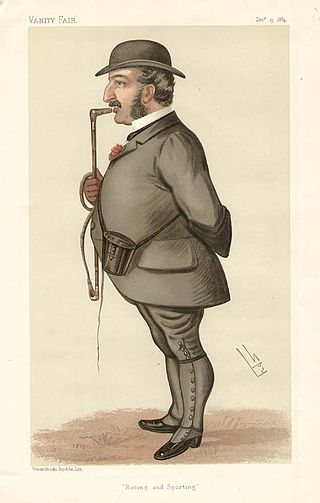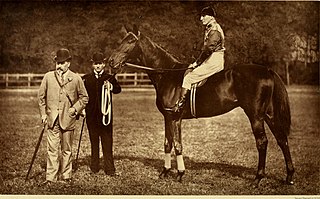This article needs additional citations for verification .(December 2016) |
William Verner Longe (31 May 1857 - 19 September 1924) was an English painter, best known for his paintings of horses.
This article needs additional citations for verification .(December 2016) |
William Verner Longe (31 May 1857 - 19 September 1924) was an English painter, best known for his paintings of horses.
Longe was born the son of Revd John Longe (1832–1916) and his wife Maria Elizabeth Verner née Martin. Longe was educated at Ipswich School, Ipswich School of Arts and Royal Academy of Fine Arts Antwerp. [1]
He was married at Brandeston, Suffolk on 5 January 1905 to Marjory Brooke (born 4 October 1881), daughter of Reginald Brooke and his wife, Jane Austin of Brandeston Hall, Suffolk and granddaughter of Francis Capper Brooke (1810–1886). [1]
William died at Springfield House, Ipswich on 19 September 1924, aged 67 and his wife died in 1949, aged 77. [1] [2]
The Prince of Wales's Stakes is a Group 1 flat horse race in Great Britain open to horses aged four years or older. It is run at Ascot over a distance of 1 mile 1 furlong and 212 yards, and it is scheduled to take place each year in June.
The King Edward VII Stakes is a Group 2 flat horse race in Great Britain open to three-year-old colts and geldings. It is run at Ascot over a distance of 1 mile 3 furlongs and 211 yards, and it is scheduled to take place each year in June.

Leopold de Rothschild was a British banker, thoroughbred race horse breeder, and a member of the prominent Rothschild family.

The New Zealand Derby is a set-weights Thoroughbred horse race for three-year-olds, run over a distance of 2,400 metres at Ellerslie Racecourse in Auckland, New Zealand. It is held on the first Saturday in March, as the opening day of Auckland Cup Week. The purse of the race in 2020 was $1 million.

The British Classics are five long-standing Group 1 horse races run during the traditional flat racing season. They are restricted to three-year-old horses and traditionally represent the pinnacle of achievement for racehorses against their own age group. As such, victory in any classic marks a horse as amongst the very best of a generation. Victory in two or even three of the series marks a horse as truly exceptional.

Papyrus (1920–1941) was a British Thoroughbred racehorse and sire. In a career that lasted from spring 1922 to October 1924, he ran eighteen times and nine races. He was a leading two-year-old in 1922 and, in the following year, he gained his most important success when he won The Derby. Later that season, he gained international attention when he was sent to New York for an unsuccessful match race against the Kentucky Derby winner Zev. This was the earliest example of a British horse being sent across the Atlantic for a single race. After running four times without winning, in 1924, he was retired to stud, where he had limited success until his death in 1941.

The Newmarket Stakes is a Listed flat horse race in Great Britain open to three-year-old colts and geldings. It is run over a distance of 1 mile and 2 furlongs (2,012 metres) on the Rowley Mile at Newmarket in late April or early May.

Brandeston is a village in Suffolk, England on the River Deben 11 miles (18 km) northeast of Ipswich. Brandeston is west of Kettleburgh and northwest of Hoo Green. It is a Parish in Plomesgate district and 3½ miles SW of Framlingham r. station."

George Lambton was a British thoroughbred racehorse trainer. He was British flat racing Champion Trainer in the 1906, 1911 and 1912 seasons.
The Deutsches St. Leger is a Group 3 flat horse race in Germany open to thoroughbreds aged three years or older. It is run at Dortmund over a distance of 2,800 metres, and it is scheduled to take place each year in September or October.

Dutch Oven (1879–1894) was a British Thoroughbred mare that won the 1882 St. Leger Stakes. Raced extensively as a two-year-old, she won nine races and £9429, but her form faltered in her late three and four-year-old seasons. Retired in 1884, Dutch Oven was not considered to be a success in the stud, but her offspring exported to Australia and Argentina did produce successful racehorses.

The Great Northern Derby was a set-weights thoroughbred horse race for three-year-old horses run over a distance of 2400 m at Ellerslie Racecourse in Auckland, New Zealand. It was discontinued in 1972 after being combined with the New Zealand Derby.

Swynford was a British Thoroughbred racehorse. Bred at the 16th Lord Derby's stud in Lincolnshire, England he was sired by John O'Gaunt, a son of Isinglass, winner of the British Triple Crown in 1893. His dam was Lord Derby's foundation mare and 1896 Epsom Oaks winner Canterbury Pilgrim who also produced Chaucer, the 1927 and 1933 Leading broodmare sire in Great Britain & Ireland.

Robert the Devil (1877–1889) was a British Thoroughbred racehorse and sire. In a career that lasted from 1879 to 1881 he ran fourteen times and won ten races. He was the leading three-year-old colt in Europe in 1880 when his wins included the Grand Prix de Paris in France and the St Leger and the Cesarewitch in England. He had a notable rivalry with the Duke of Westminster's colt Bend Or, winning three of their five racecourse meetings. Robert the Devil was regarded by contemporary observers as one of the greatest horses of the 19th century. He had limited success at stud and died in 1889.

Tristan (1878–1897) was a British Thoroughbred racehorse and sire. In a career that lasted from the April 1880 to October 1884, he ran 51 times and won 27 races. A useful performer at two and three years old, he matured into an outstanding horse in his last three seasons, winning important races at distances ranging from six furlongs to two and a half miles and defeating three winners of The Derby. Unusually for a 19th-century racehorse, he was regularly campaigned internationally, winning three consecutive runnings of the Grand Prix de Deauville. Tristan's success was achieved despite a dangerous and unpredictable temperament: at the height of his success, he was described as "a very vile-tempered animal".

Formosa (1865–1881) was a British Thoroughbred racehorse that was the first winner of the English Fillies Triple Crown in addition to running a dead heat with the colt Moslem for the 2,000 Guineas Stakes. Formosa was bred by James Cookson and was foaled in 1865 at his Neasham Hall stud farm. Formosa was sold to William Graham in 1866 and raced her entire three-year racing career under his ownership. After her racing career ended in 1871, she became a broodmare for Graham until his death in 1876. Formosa was exported to France in 1879 and died there in February 1881. While she did not produce offspring that excelled at racing, her daughters that were exported to Germany and New Zealand did produce descendants that were successful racers.

Richard Marsh MVO (1851–1933) was a British trainer of racehorses. After his promising career as a jockey was ended by his rising weight, Marsh set up as a trainer in 1874. He trained from a number of stables before eventually making his base at Egerton House in Newmarket, Suffolk. In a training career of fifty years, Marsh trained the winners of twelve British Classic Race and many other major races. His greatest success sprang from his association with King Edward VII, for whom he trained three winners of The Derby. Two of Marsh's sons later became successful trainers.
James "Old Jim" Wilson was a racehorse trainer in Victoria, Australia, founder of the historic St Albans Stud in Geelong, and trainer of the 1873 Melbourne Cup winner Don Juan and 1876 winner Briseis. His older son James Wilson, Jr. captained the Geelong Football Club and as "Young Jim Wilson" trained 1899 Cup winner Merriwee. His younger son William Wilson was the jockey who rode Don Juan to victory in the 1873 Cup.
Ellangowan was a British Thoroughbred racehorse and sire. He raced only once as a two-year-old but showed considerable promise when finishing third in a top-class event at Kempton. In the following spring he came in third in the Craven Stakes before recording his biggest win in the 2000 Guineas. Although be made no impact in the Epsom Derby or the St Leger, he had further major victories in the St James's Palace Stakes and the Champion Stakes. He failed to win in 1924 and was retired to stud, but had little success as a breeding stallion.
Canterbury Pilgrim (1893–1917) was a British Thoroughbred racehorse and broodmare. She showed some ability as a juvenile but failed to win a race. She won the Oaks Stakes on her first run as a three-year-old and went on to win the Liverpool Summer Cup, Park Hill Stakes and Jockey Club Cup before being retired at the end of the year. As a broodmare the best of her offspring was Swynford, a top-class racehorse who was even better as a breeding stallion. She also produced the influential sire Chaucer and several good broodmares. She has been described as "one of the most influential horses, stallion or mare, of the Twentieth Century".